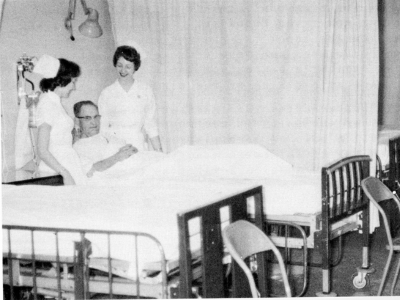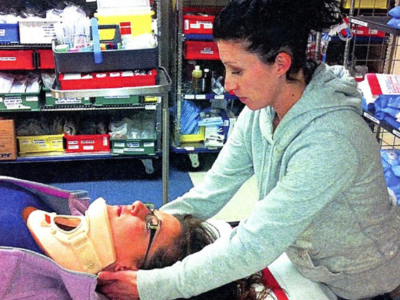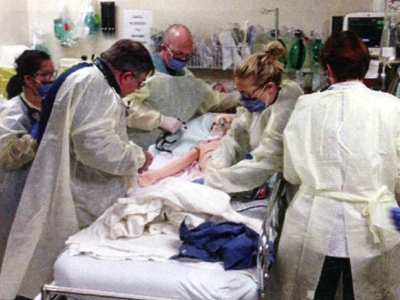
A corner of the plaster room is featured here from the Emergency Department at Victoria Hospital (South Street location) in 1960.
November 12, 2025
As we celebrate the 150th anniversary of our hospital, it's impossible not to reflect on how far we've come, especially in the fast-paced, ever-evolving environment of the Emergency Department (ED). It also reminds us of how important this department is to our community in their most urgent moments of need.
From its opening in the early 1940s, the Emergency Department has evolved and grown in size to meet the needs of patients and the ever-changing advancements in medicine and technology.
A modest beginning
The Emergency Department at Victoria Hospital on South Street opened in the early 1940s, staffed by just a handful of individuals, including a physician, intern, nurse, orderly, and clerk. Many of the physicians in the ED were also family physicians and performed minor patient surgeries and procedures in-house. Located just across the street from the original War Memorial Children's Hospital, the department also treated many paediatric patients. War Memorial Children’s Hospital would stay at its location on Colborne and South Streets until 1985 when it was relocated to Victoria Hospital’s Westminster site on Commissioners Road.
When the North tower at South Street’s Victoria Hospital opened in 1941, the ED had been unchanged until renovations were completed in the winter of 1960. Those upgrades created more opportunities to support the community with six new receiving beds, two operating rooms, three treatment areas, and improved access to X-rays or plaster rooms. Piped oxygen and suction equipment were also introduced in some areas along with full emergency operating equipment in the operating rooms, bringing new capabilities to emergency care. Emergency cases continued to enter through the admitting entrance and were received by the nurse in charge.



By fall of 1968, more upgrades were made to the Admitting and Emergency Departments which were intended to hold the hospital over until the proposed Centennial Building could be built where an entirely new department would be constructed. Ultimately, the Centennial building was never built, but the changes set the stage for future expansions.In December of 1986, Dr. Jon Dreyer and his team in the South Street Emergency Department simulated work on an “accident patient” (Harvey Sullivan, president of Victoria Hospital) as part of a demonstration of the ED crew in action for board members touring the department during Emergency Week.
From South Street to Westminster
In 2005, a major milestone occurred with the official relocation of the Emergency Department from the South Street location to the newly acquired Westminster Hospital, which became the new Victoria Hospital site. In its final year of operation, the department treated on average 143 patients per day. 
By the middle of the 1980s, the Emergency Department saw almost 60,000 patients annually and was responsible for 10,000 admissions a year. At the time, this was one of the largest Emergency Departments in Canada and was the base for Western University’s Emergency Medicine Training Program. By 1990, the Critical Care Trauma Unit consisted of 30 beds and proved to be an integral part of the hospital. Today, both University Hospital and Victoria Hospital provide emergency care to over 150,000 patients yearly.
When University Hospital opened in September 1972, it also brought a new Emergency Department to the City of London. By the 1990s and early 2000s, the University Hospital ED was treating more than 30,000 patients a year with those numbers projected to grow In response, the ED was moved to a new space in the summer of 2003, tripling in size with the ability to accommodate up to 70,000 patients per year. University Hospital is also home to the Regional Stroke Centre and is one of 41 hospitals in Ontario that has a designated stroke unit that works in direct coordination with the Emergency Department.
Innovations and training in the Emergency Department
The evolution of the Emergency Department hasn’t just been about the locations and the technology, but also the way the teams have evolved to make patient care safer, faster and smarter. Back in 2011, triage nurses in the Victoria Hospital ED created a certification program allowing nurses to “clear” low acute neck injuries at triage and remove stiff neck collars by following the Canadian C-spine rule.
Located on Commissioners Road, Victoria Hospital and Children’s Hospital each offered emergency care for children and adults within the same facility yet operating separately, becoming the only co-located adult/paedatric ED of its kind in Canada.
Emergency Departments host regularly scheduled simulated medical emergencies to perfect their crisis management skills. While typically held after-hours or when there are lower patient volumes, these simulations allow participants to analyze their communication and issues response and examine areas of improvement such as medication placement, access to equipment, or workflow of the team.

By adopting these processes, the EDs have been able to enhance patient experience, efficiency, and demonstrate the ongoing commitment to quality improvement.

One impactful addition to the ED in recent years has been the introduction of Emergency Department Technicians (EDTs). With varied backgrounds and specialized on-the-job training, EDTs have become invaluable members of the care team, assisting with crutching, retrieving equipment, or checking patient vitals.


As we mark 150 years of service, the story of our Emergency Department is one of growth and community connection. From a small room with a few staff to cutting-edge facilities treating thousands annually, the ED has never stopped.
“The ED is a unique place in our hospital, it is a true team working together to provide emergency care to our patients and our community” says Dr. Christie MacDonald.
LHSC is celebrating 150 years of care, innovation, and community impact by sharing 150 moments from our history. Join us in marking this milestone by sharing your own LHSC story.
